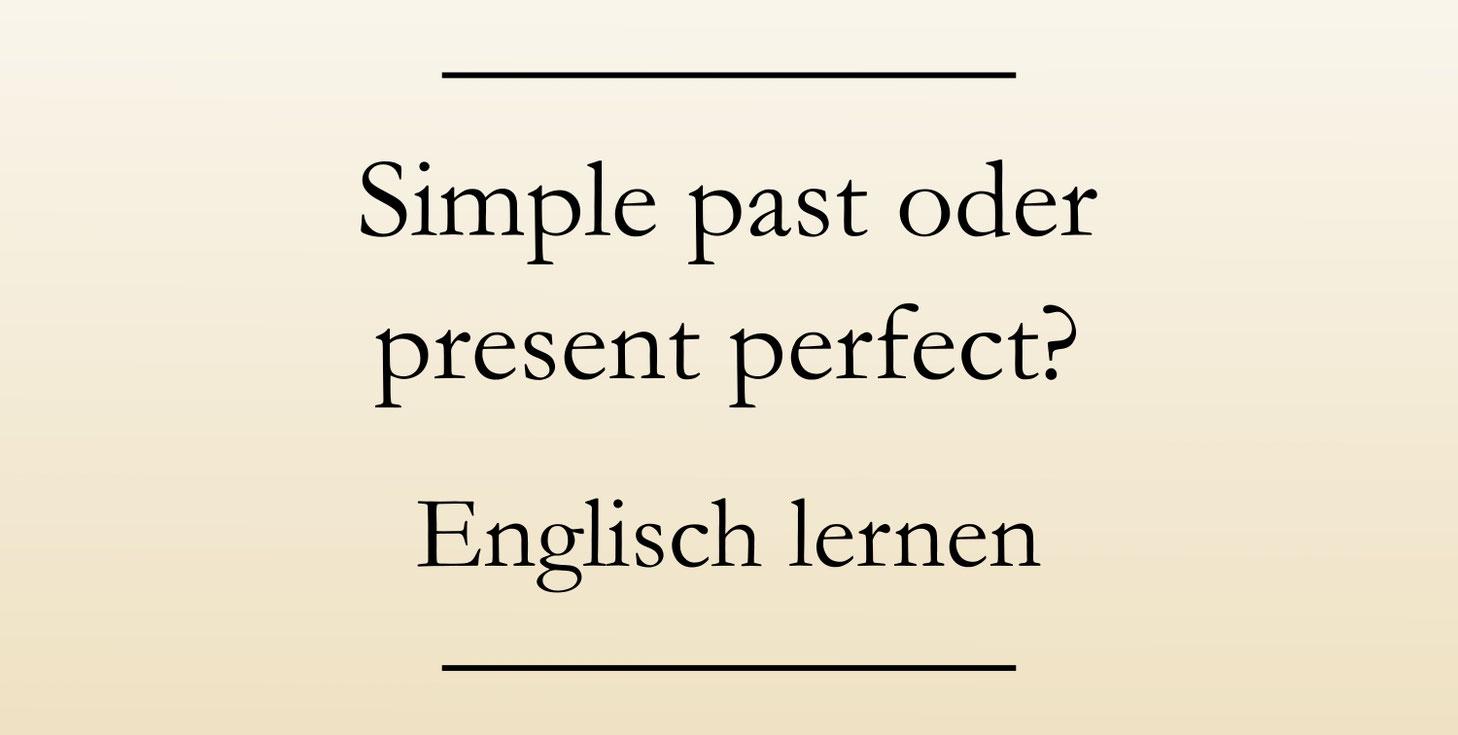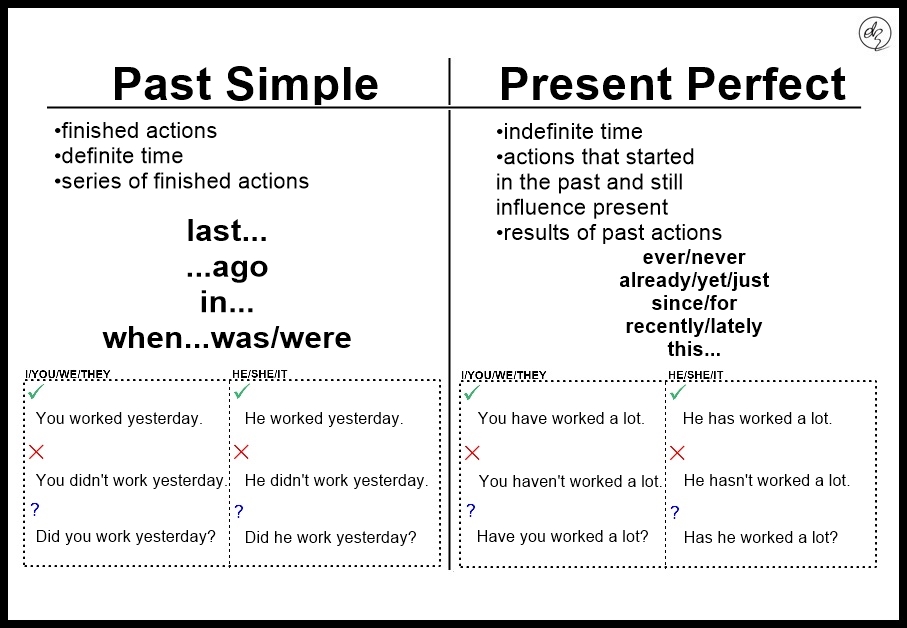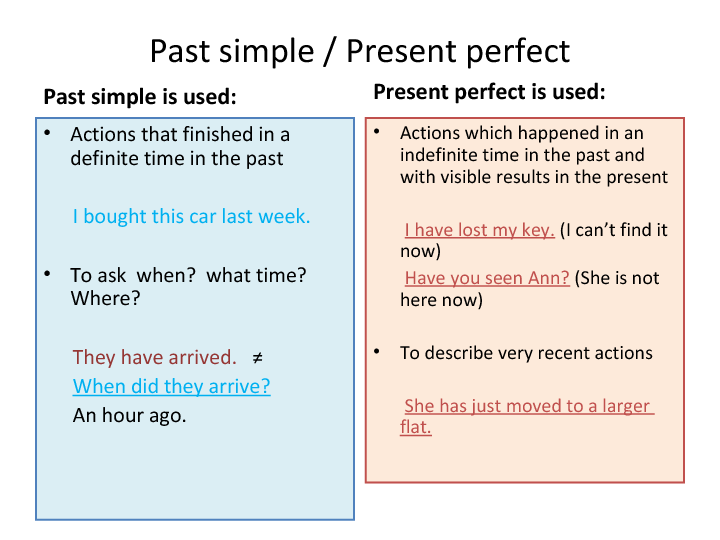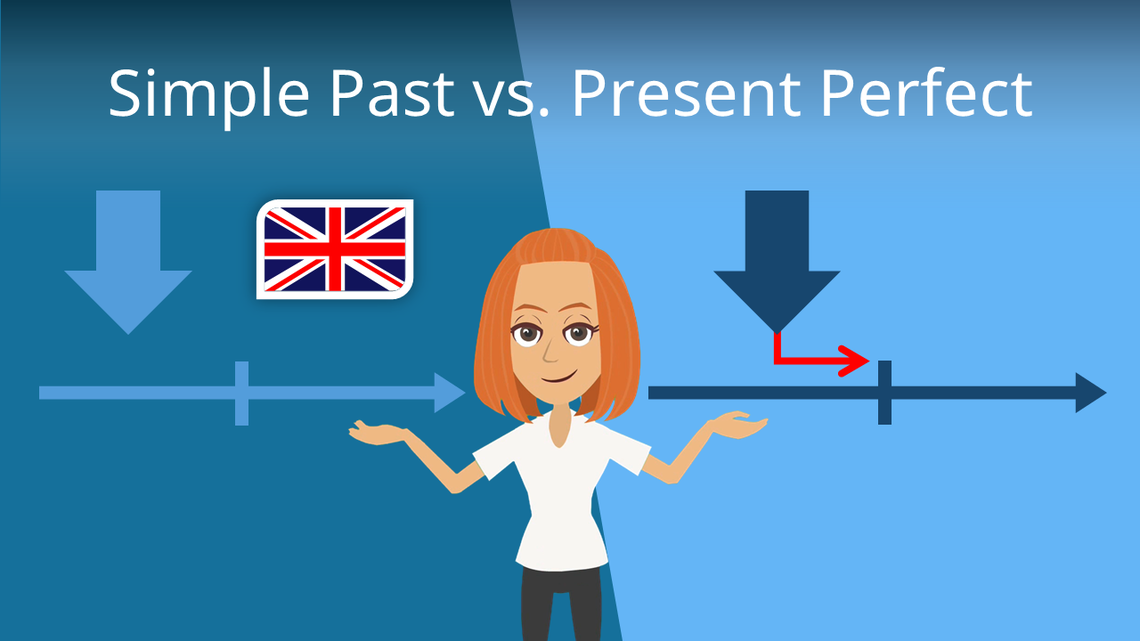
Simple past oder present perfect? Unterschied Englisch lernen
Gegenüberstellung Simple Past - Present Perfect Simple Bildung Siehe auch Erläuterung zum Simple Past und Present Perfect Simple Verwendung Beide Zeitformen gibt es auch im Deutschen, aber wir unterscheiden meist nicht so streng zwischen Perfekt und Präteritum. Im Englischen (britisches Englisch) haben beide Zeiten eine bestimmte Funktion.

PAST SIMPLE vs. PRESENT PERFECT
Das present perfect: Die unvollendete Vergangenheit Du verwendest das present perfect, wenn du über Ereignisse und Handlungen sprichst, die in der Vergangenheit angefangen haben, aber noch nicht abgeschlossen sind oder noch bis in die Gegenwart anhalten: I have never been to New York.

PresentperfectvsPastsimpleinfographic Present perfect, English grammar, Learn english
Key difference 2: present perfect actions happened in the past, but are connected to the present. simple past actions started and finished in the past. Examples: Chris can't come on the trip, he has broken his leg. (present perfect) his leg is still broken. I broke my leg when I was fifteen. (simple past)

In plain English SIMPLE PAST OR PRESENT PERFECT?
#eureFragen Hast du auch eine Frage? Schreibe sie in die Kommentare!Kapitel:0:00 - 1️⃣ Übersicht0:20 - 2️⃣ Bildung0:45 - 3️⃣ wann welche Zeit2:05 - 4️⃣ Signa.

English Tenses Present Perfect Simple vs. Present Perfect Continuous ESLBuzz Learning English
Here are the basic differences between these two tenses: Time Specificity: The past simple is time-specific, while the present perfect is not. Relevance to Present: Present perfect actions are usually relevant to or affect the present; past simple actions do not. Time Markers: Past simple often uses specific time markers, while present perfect.

Present Perfect vs Past Simple Useful Differences Efortless English
Past simple or present perfect? - English Grammar Today - a reference to written and spoken English grammar and usage - Cambridge Dictionary

Past Simple vs. Present Perfect
Spelling (Present Perfect and Simple Past) stopp ed (Double the consonant after a short vowel.) love d (one -e at the end of the word → Add only -d.) worri ed (consonant before -y → Change to -i.) Explanation. Present Perfect (Summary) Simple Past (Summary) Exercises. Exercises - Present Perfect and Simple Past contrasted;

present perfect vs simple past Present perfect, Grammar worksheets, English grammar worksheets
Remember: We use the past simple for past events or actions which have no connection to the present. We use the present perfect for actions which started in the past and are still happening now OR for finished actions which have a connection to the present. We CAN'T use the present perfect with a finished time word: NOT: I've been to the museum.

Unterschied Present Perfect und Simple Past! Englisch verstehen mit dem Studienkreis YouTube
Past simple deals with completed actions or events in the past, while present perfect is used to express past actions that have a connection to the present. The choice of tense not only affects sentence structure but also shapes the meaning and interpretation of any statement.

CHARTS Simple Past and Present Perfect PDF
The key difference between the simple past and the present perfect lies in their focus on when an action occurred and its connection to the present: The simple past is used for actions that happened at a specific point in the past as in "I watched a movie last night.". However, the present perfect is used for actions that started in the.

Past Tense Simple vs. Present Perfect Simple (Intermediate Level) Unterrichtsmaterial im Fach
Simple Past vs. Present Perfect: Hauptunterschiede. Es gibt es zwei Hauptunterschiede, die uns bei der Gegenüberstellung von Simple Past und Present Perfect helfen können:. Hauptunterschied 1: Simple Past bezieht sich auf eine bestimmte Zeit in der Vergangenheit; Present Perfect drückt nur aus, das die Handlung stattfand — aber nicht wann; Beispiel: I went to Norway in 2014.

Wann benutzt man simple past und wann present perfect ? BildFragen.de
Beschreibung: Übung zum Unterschied simple past/ present perfect Ein 4teachers-Material in der Kategorie: 4teachers/Unterricht/Arbeitsmaterialien/Englisch/Unterstufe - Forms 05 - 06/Grammar/Verbs/Tenses/Present Perfect vs. Past/ » zum Material: Simple past/ Present perfect Stundenentwürfe Arbeitsmaterialien Lehrershop Schulplaner Verlagsmaterialien

Past Simple and Present Perfect (With images) Present perfect, Learn english, Learn english
Welche Unterschiede und welche Gemeinsamkeiten haben Present Perfect und Simple Past? 1. Verwendung 2. Signalwörter 3. Bildung * past participle : regelmäßige Verben → Infinitiv + -ed unregelmäßige Verben → 3. Spalte der Tabelle der unregelmäßigen Verben 4. Beispiele 4.1. Bejahte Aussagesätze 4.2. Verneinte Aussagesätze 4.3. Fragen

Past Simple vs Present Perfect сравнение времен
Simple Past - Present Perfect: Bildung (00:15) Simple Past - Present Perfect: Verwendung (01:09) Simple Past - Present Perfect: Signalwörter (02:14) Gemeinsame Besonderheiten (02:52) Das Simple Past und auch das Present Perfect sind Zeitformen der Vergangenheit in Englisch.

Differences Between Present Perfect Tense and Simple Past Tense English Study Page Simple
Unterschied: Present Perfect und Simple Past Video Lerntext Übungen Fragen? Inhaltsverzeichnis: Verwendung des Simple Past Verwendung des Present Perfect Gegenüberstellung Present Perfect und Simple Past Hier lernst du den Unterschied zwischen Simple Past und Present Perfect kennen. Simple Past oder Present Perfect?

Ficha de Trabalho Past Simple Vs Present Perfect (1)
The simple past uses a single verb (the simple past form of the verb) while the present perfect uses two verbs (has/have + participle form of the verb). Here are some examples: The English Tenses: A Brief Introduction Tenses are a way of measuring time. They tell us whether a particular action has already happened, is happening or will happen.